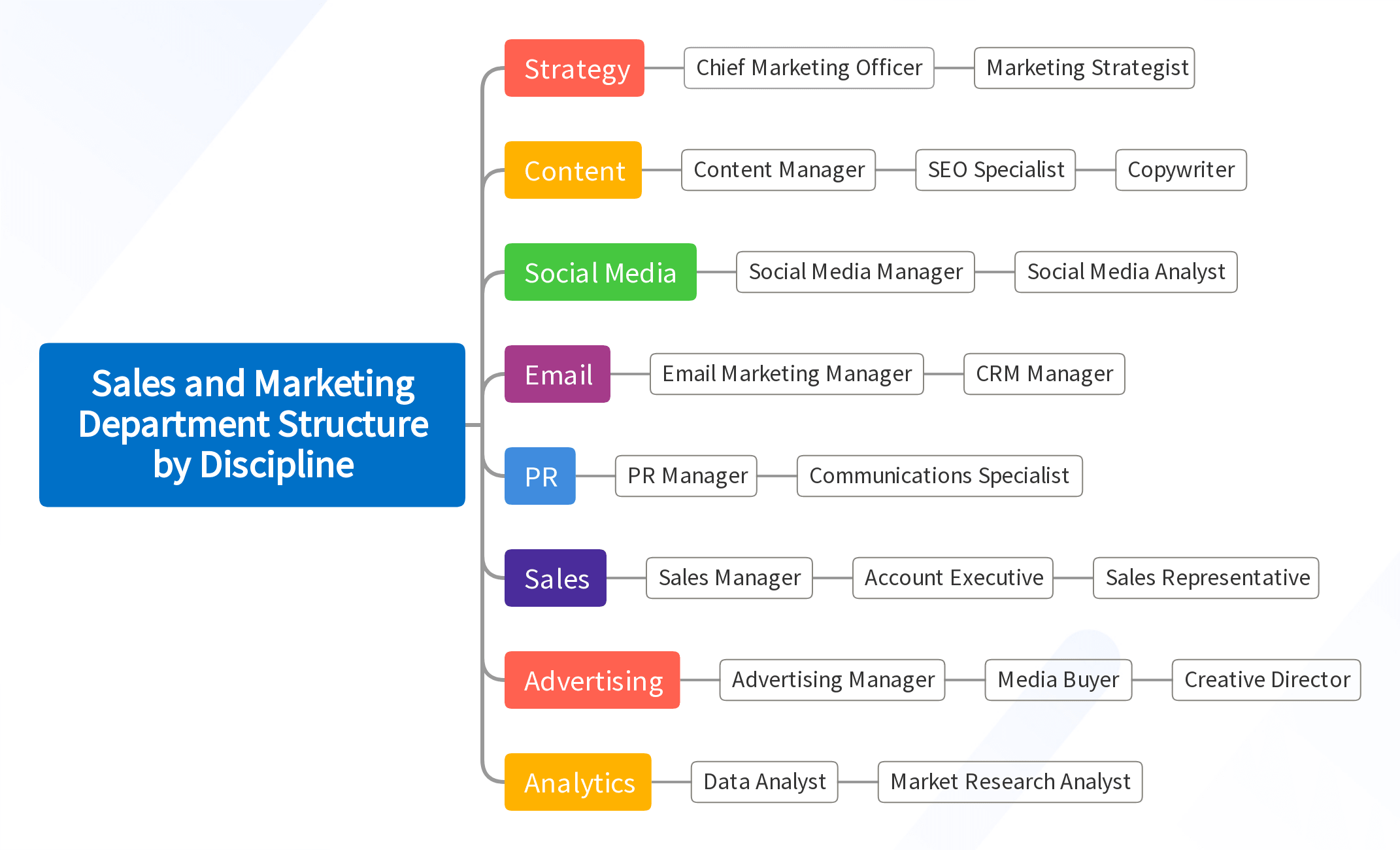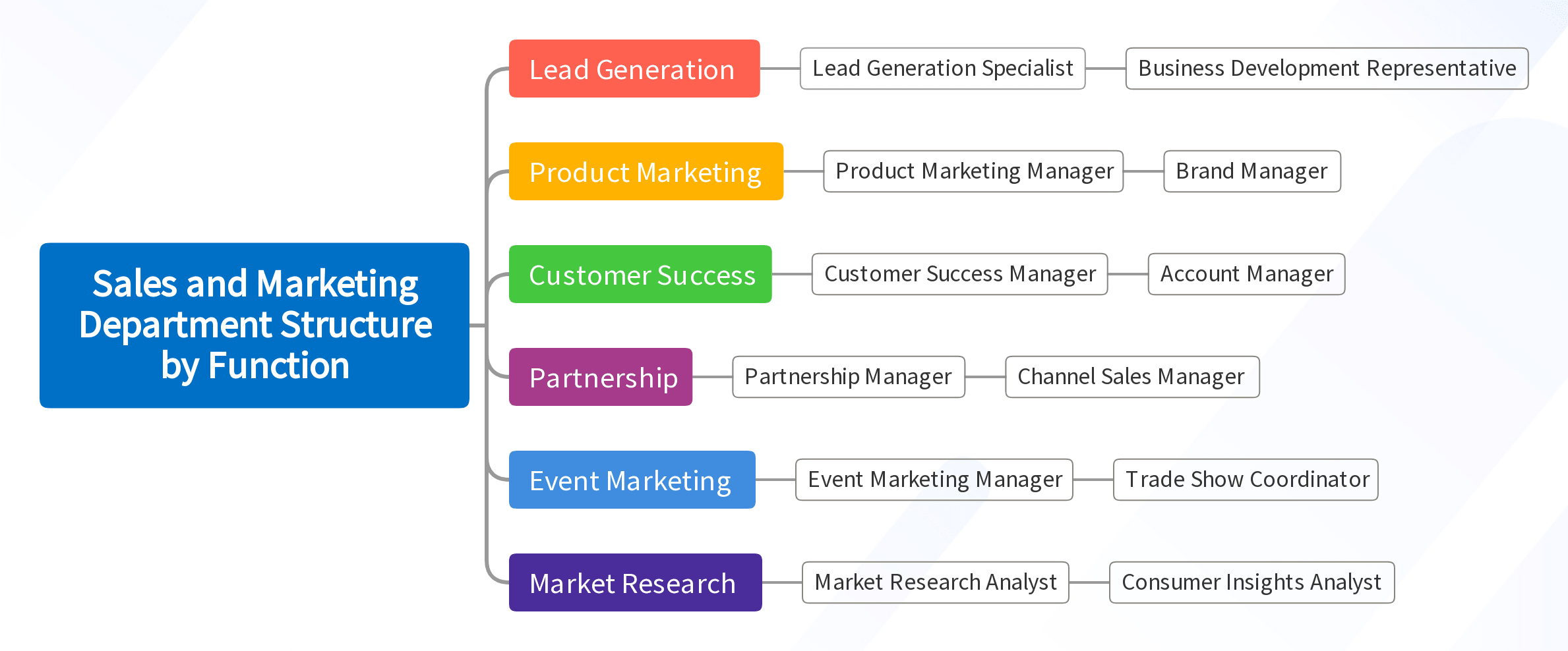

Sales and marketing teams are pivotal in today's business world. Their roles are dynamic, shaping the very heart of enterprises.
Approaching their structure correctly is key. It can fuel growth, foster customer engagements, and drive profitability. I've learned this firsthand while growing my own marketing agency, GrantSpark.
But first, let's talk about the Sales and Marketing department structures you have to choose from.
Best for Growth Marketers
Best for Paid Ads & CMO's
Table of Contents
Structuring Sales and Marketing Department
There are two main types of department structures based on company size and resources.
- Sales and Marketing department structure by discipline
- Org Type: Traditional corporate departments
- Best For: Midsize/Enterprise companies
- Sales and Marketing department structure by function
- Org Type: Employees are grouped by activities and objectives
- Best For: Small to Medium Sized Business (SMB)
Let’s go in-depth to each one of them.
1. Sales and Marketing Department Structure by Discipline


Discipline-based structure involves building teams centered around various marketing disciplines. For example, SEO, Content, Market Research, and Product Strategy could each form separate teams within a department.
| Discipline | Key Skills | Potential Roles |
|---|---|---|
| Strategy | Market Analysis, Strategic Planning, Competitive Analysis | Chief Marketing Officer, Marketing Strategist |
| Content | Content Creation, SEO, Copywriting | Content Manager, SEO Specialist, Copywriter |
| Social Media | Social Media Management, Content Planning, Analytics | Social Media Manager, Social Media Analyst |
| Email Marketing, CRM, Segmentation | Email Marketing Manager, CRM Manager | |
| PR | Media Relations, Press Release Writing, Event Planning | PR Manager, Communications Specialist |
| Sales | Product Knowledge, Relationship Building, Negotiation | Sales Manager, Account Executive, Sales Representative |
| Advertising | Ad Campaign Management, Media Buying, Creativity | Advertising Manager, Media Buyer, Creative Director |
| Analytics | Data Analysis, Market Research, Reporting | Data Analyst, Market Research Analyst |
2. Sales and Marketing Department Structure by Function


Another approach is structuring by function, where teams are formed based on the different functions they perform. For example, promotion, launches, and relationship management could all be separate teams.
| Function | Key Skills | Potential Roles |
|---|---|---|
| Lead Generation | Prospecting, Communication, CRM Software | Lead Generation Specialist, Business Development Representative |
| Product Marketing | Product Knowledge, Market Research, Positioning | Product Marketing Manager, Brand Manager |
| Customer Success | Customer Relationship, Problem Solving, Product Knowledge | Customer Success Manager, Account Manager |
| Partnership | Relationship Building, Strategic Planning, Negotiation | Partnership Manager, Channel Sales Manager |
| Event Marketing | Event Planning, Communication, Project Management | Event Marketing Manager, Trade Show Coordinator |
| Market Research | Data Analysis, Survey Design, Report Writing | Market Research Analyst, Consumer Insights Analyst |
Sales and Marketing Team Size versus Business Scale
To achieve successful marketing outcomes, you need to align the team size with your business's scale – a strategic approach that helps optimize resources and drive targeted growth.
| Business Scale | Ideal Department Size | Explanation |
|---|---|---|
| Start-up | 1-10 | Minimal staff needed due to limited operations. |
| Small-Medium Business | 10-50 | Increased demand requires a larger, more specialized team. |
| Large Enterprise | 50+ | Large-scale operations necessitate extensive team. |
Factors to Consider When Deciding On a Sales and Marketing Department Structure
- Business Goals: Understand the company's objectives. The structure of your sales and marketing team should align with the business's primary goals, whether it's growing market share, launching new products, or increasing customer retention.
- Customer Preferences: Take into account your customers' preferences. The team should be organized in a way that best serves your customers and meets their needs, from the channels they prefer for communication to the types of content they consume.
- Team Skills: Evaluate the skills and strengths of your team. A successful sales and marketing team requires a balanced mix of skills, from data analysis and market research to creativity and communication.
- Company Size: Consider the size of your business. Larger companies may need more specialized roles, while smaller businesses might require team members to wear multiple hats.
- Industry Trends: Stay updated with industry trends. The structure of the team should be flexible enough to adapt to changing market conditions and trends, ensuring the business remains competitive.
Explore other marketing departments:
- B2B SaaS Marketing Team Structure
- Recruitment Marketing Team Structure
- Ecommerce Marketing Team Structure
So, there you have it, a detailed overview of a Sales and Marketing team structure. From the essence of the team and key roles, to structuring and optimizing; every aspect tailored to achieve success on your business blueprint.


















